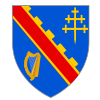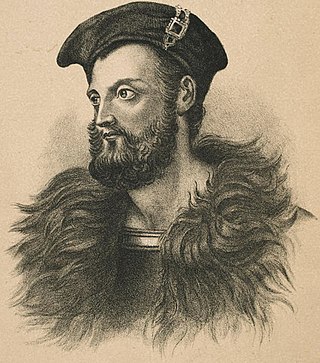
Owen Roe O'Neill was a Gaelic Irish soldier and one of the most famous of the O'Neill dynasty of Ulster. O'Neill left Ireland at a young age and spent most of his life as a mercenary in the Spanish Army serving against the Dutch in Flanders during the Eighty Years' War. After the Irish Rebellion of 1641, O'Neill returned and took command of the Irish Confederate Ulster Army. He is known for his victory at the Battle of Benburb in 1646.

Charles Blount, 1st Earl of Devonshire, KG was an English nobleman and soldier who served as Lord Deputy of Ireland under Queen Elizabeth I, and later as Lord Lieutenant of Ireland under King James I.

Viscount Charlemont is a title in the Peerage of Ireland. It was created in 1665 for William Caulfeild, 5th Baron Charlemont.

The Irish Confederate Wars, also called the Eleven Years' War, took place in Ireland between 1641 and 1653. It was the Irish theatre of the Wars of the Three Kingdoms, a series of civil wars in the kingdoms of Ireland, England and Scotland – all ruled by Charles I. The conflict had political, religious and ethnic aspects and was fought over governance, land ownership, religious freedom and religious discrimination. The main issues were whether Irish Catholics or British Protestants held most political power and owned most of the land, and whether Ireland would be a self-governing kingdom under Charles I or subordinate to the parliament in England. It was the most destructive conflict in Irish history and caused 200,000–600,000 deaths from fighting as well as war-related famine and disease.

Sir Phelim Roe O'Neill of Kinard was an Irish politician and soldier who started the Irish rebellion in Ulster on 23 October 1641. He joined the Irish Catholic Confederation in 1642 and fought in the Wars of the Three Kingdoms under his cousin, Owen Roe O'Neill, in the Confederate Ulster Army. After the Cromwellian conquest of Ireland O’Neill went into hiding but was captured, tried and executed in 1653.

The Cromwellian conquest of Ireland or Cromwellian war in Ireland (1649–1653) was the re-conquest of Ireland by the forces of the English Parliament, led by Oliver Cromwell, during the Wars of the Three Kingdoms. Cromwell invaded Ireland with the New Model Army on behalf of England's Rump Parliament in August 1649.

The Battle of Scarrifholis, also spelt Scariffhollis was fought on 21 June 1650, near Letterkenny in County Donegal during the Cromwellian conquest of Ireland. A force loyal to the Commonwealth of England commanded by Charles Coote defeated the Catholic Ulster Army, commanded by Heber MacMahon, Roman Catholic Bishop of Clogher.
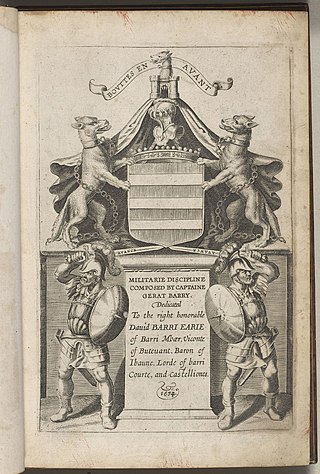
Garret Barry, also called Gerat, was an Irish soldier and military writer, who fought for Spain in the Eighty Years' War and then for the Irish insurgents in the Rebellion and the Confederate Wars. When young he left Kinsale at its surrender in 1602 for Spain where he took service, first as marine in the Atlantic Fleet and then in the Army of Flanders. While in Spanish service, he fought at the Siege of Breda in 1624/1625. He retired with the rank of captain in 1632. Returning to Ireland he was at the Rebellion appointed general of the insurgents' Munster Army. He took Limerick in June 1642 but was defeated at Liscarroll by Inchiquin in September. He was confirmed as General of the Munster Army by the Irish Catholic Confederation but was in practice superseded by Castlehaven in 1643.
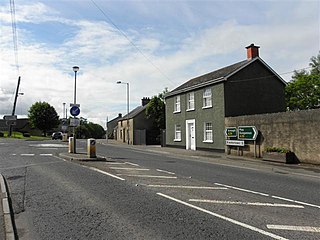
Charlemont is a small village in County Armagh, Northern Ireland. It sits on the right bank of the River Blackwater, five miles northwest of Armagh, and is linked to the neighbouring village of Moy by Charlemont Bridge. It had a population of 109 people at the 2011 Census.
James Hamilton, 3rd Lord Hamilton, Baron of Strabane (1633–1655) fought against the Cromwellian conquest of Ireland together with his stepfather Phelim O'Neill. In the Siege of Charlemont of 1650, they defended the fort against Coote, but had eventually to surrender. In 1655 Lord Strabane accidentally drowned in the River Mourne near Strabane, aged about 22 and was succeeded by his brother George.
George Hamilton, 4th Baron Hamilton of Strabane was the younger son of Claud Hamilton, 2nd Baron Hamilton of Strabane. He succeeded to the title in 1655 when his brother drowned while bathing in the River Mourne. After the Restoration, he obtained the return of the family lands around Strabane, which had been confiscated by the Parliamentarians in 1650.
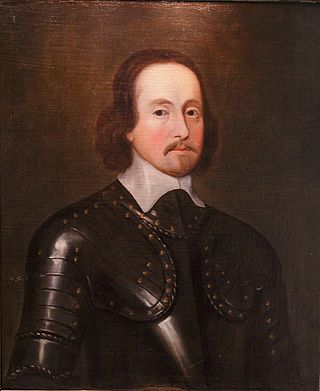
The Battle of Lisnagarvey was fought on 6 December 1649, near Lisnagarvey, County Antrim, during the Irish Confederate Wars, an associated conflict of the 1638 to 1651 Wars of the Three Kingdoms. Forces loyal to the Commonwealth of England defeated an army supporting Charles II of England, composed of Royalists and Scots Covenanters.

Charles Coote, 1st Earl of Mountrath was an Anglo-Irish peer, the son of Sir Charles Coote, 1st Baronet, and Dorothea Cuffe, the former being an English veteran of the Battle of Kinsale (1601) who subsequently settled in Ireland.
The siege of Charlemont took place in July – 14 August 1650 during the Cromwellian conquest of Ireland when the fortress of Charlemont in County Armagh Ireland was besieged by Charles Coote's Parliamentarian army, which was largely composed of soldiers of the New Model Army. The force led by Coote eventually took the fort from its Irish defenders, but not before they suffered heavy losses, with some 500 Parliamentarian Soldiers being killed during assaults on the formidable stronghold. In terms of the number of soldiers killed in battle, the siege of Charlemont was the second bloodiest engagement fought by the Parliamentarians in Ireland, only surpassed by the siege of Clonmel.
Presented below is a chronology of the major events of the Irish Confederate Wars from 1641 to 1653. This conflict is also known as the Eleven Years War. The conflict began with the Irish Rebellion of 1641 and ended with the Cromwellian conquest of Ireland (1649–53).
Colonel Gordon O'Neill, was an officer in King James II's Irish army who fought at the Siege of Derry, the Battle of the Boyne, and the Battle of Aughrim for the Jacobites. He was a son of Sir Phelim O'Neill, who started the Irish Rebellion of 1641.
Toby Caulfeild, 1st Baron Caulfeild of Charlemont (1565–1627) was an English army officer active in Ireland.
Toby Caulfeild, 3rd Baron Caulfeild of Charlemont (1621–1642) was an Anglo-Irish politician.

The Battle of Clones occurred on 13 June 1643 during the Irish Confederate Wars, when Irish Confederate forces commanded by Eoghan Ruadh Ó Néill were decisively defeated near Clones in County Monaghan by the Protestant Laggan Army commanded by Sir Robert Stewart.













